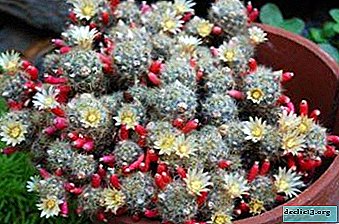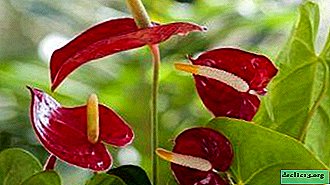Unpretentious cactus Mammillaria Wilda: description, photos and tips for caring for the plant

Mammillaria wilda is a widespread plant belonging to the Cactus family. Representatives of this species (Wild) are the most unpretentious, and therefore practical indoor plants.
This is a great option for lovers of exotic. This article will tell you what care is needed for the prickly beauty so that she pleases with her flowering healthy look.
Botanical Description
Mammillaria wilda - small cactus, has a shape close to the ball, or a short cylinder (in most cases, the representatives of this species are cylindrical).
In height, it can reach 8–15 cm, and in width 4–6 cm. The cylindrical stem branches abundantly from the base itself, near which colonies appear in a short period of time. It also has soft papillae with a length of 6 - 10 mm and a diameter of 3 - 6 mm, at the base they have a pinkish tint.
Axillas can have one or several hair-like bristles, and spines are radial, their number is 8 - 10 pieces, can be either transparent or pale yellow, 6 - 8 mm long.
The flowers are creamy white, their length reaches 1 - 2 cm, and berries are formed only after pollination.
Photo
Next, you can see the photo of the plant:





Features and differences from other species
A plant belonging to this species belongs to the few mammillaria that cannot tolerate direct sunlight at all, while others need as much sunlight as possible, which directly determines the intensity and brightness of their flowering.
Reference! Mammillaria Wilda differs especially from others in that it is extremely unpretentious and almost does not require attention.How to care?
- Lighting. As mentioned above, the main feature of this type of Mammillaria is its dislike of direct sunlight, therefore it is necessary to provide bright diffused sunlight.
- Watering. Throughout the winter, you need to water the plant very moderately: about 1 time per month, just to moisten the top layer of the substrate. The lower the temperature around the cactus, the smaller the amount of water for irrigation. And with the beginning of spring, watering becomes more and more.
From May to the end of June - a period when you need to water moderately or even abundantly, i.e. about 3-4 times a month. Already in August, a gradual decrease in the amount of water begins, and in October it is finally limited. It is important that the liquid is settled and at room temperature.
- Temperature. During the dormant period that occurs in winter, the most optimal temperature is 7 - 10 degrees, higher temperatures are highly not recommended. And in the summer, the cactus can be in a room with room temperature, and it is important to ventilate it, as absolutely all Mammillaria, including this species, prefer exclusively fresh air.
- Top dressing. Feeding Mammillaria Vilda, like other species, is rare: once every 2 weeks during a period of active growth (from early May to late July). As a fertilizer, it is recommended to use a complex mineral mixture in liquid or highly soluble form.
In winter (during dormancy) it is impossible to fertilize a cactus!
- Substrate. For the young Mammillaria Vilda, a substrate consisting of the following components in certain proportions is ideal:
- Soddy soil - 1 part.
- Leaf soil - 1 part.
- Peat land - 1 part.
- Sand - 1 part.
- Brick chips - 0.5 parts.
For adults and "older" cacti, almost the same composition, only one difference: not 1, but 2 parts of sod soil are added.
- Pot. It is precisely because colonies (children) appear very quickly around the base of Mammillaria Wilde that the wide and shallow capacity should be selected in moderation.
How to transplant?
Young cacti of this species need to be replanted every year, and adults and old ones every 2 years. Before carrying out this procedure, you need to give the substrate in which the plant is, dry slightly (do not water it for about 10 days).
Step-by-step instruction:
 After the earthen coma has dried, you need to remove the cactus from the pot and carefully examine its root system for damage. It is important to look at the neck very well - most often there are pests.
After the earthen coma has dried, you need to remove the cactus from the pot and carefully examine its root system for damage. It is important to look at the neck very well - most often there are pests.- Trim dead and damaged roots with sterile sharp scissors.
- Pour a little crushed activated carbon into the places of cuts and wounds.
- Before directly placing the cactus in a new substrate, rinse it under hot water with the addition of an insecticide.
- After washing, the cactus must be dried in an upright position (this will take 4 days).
- Place the dry plant in a new pre-prepared substrate (how to do this, as described above).
How to crop?
This procedure is performed extremely rarely, only when there is an excessive lengthening of the upper part of the stem, and the older the cactus, the more its lower part settles. For some time, while the plant is young, the settled part with dry and yellowed papillae can be sprinkled with small pebbles, but this cannot be done endlessly. In this case, it is necessary to resort to pruning Mammillaria:
- Carefully inspect the stem of Mammillaria Vilda and find a clear boundary between the settled and normal parts.
- Carefully cut off the normal part with a sanitized sharp blade.
- Root the cut portion like a stalk.
Wintering
In winter, this species of Mammillaria, like any other, begins a dormant period - a time when the plant does not bloom, and its growth slows down. But at the same time, Mammillaria Wilda does not lose the ability to bloom for this time, it is simply expressed to a lesser extent, i.e. it’s not a fact that flowers will appear on the plant, but this is entirely possible. During the dormant period, the cactus rests and gathers strength before a more active flowering from May to July, so it should be watered less often and not be fed at all, because it will only bring him harm.
Breeding
- Lateral shoots (children). Of the two methods of reproduction, this method is the simplest, this is its main plus. The downside is that gradually this leads to the degeneration of the plant (after some time, the spikes and stems of the planted children become smaller and thinner), so sometimes you need to switch to seed propagation. Step-by-step instruction:
- Carefully separate the daughter shoots from the mother plant, allow it to dry for 1-2 days.
- Prepare the soil in a small pot.
- Place a shoot in it, sprinkle with a substrate to the root neck.
- Place the pot in a dark place for 3 days.
- Moderately water the plant after a week.
 The seeds. The seeds of the Mammillaria Vilda actively germinate with constant heating of the substrate of 20 - 25 degrees. This method will take much longer, but will guarantee the appearance of large and beautiful cacti. Step-by-step instruction:
The seeds. The seeds of the Mammillaria Vilda actively germinate with constant heating of the substrate of 20 - 25 degrees. This method will take much longer, but will guarantee the appearance of large and beautiful cacti. Step-by-step instruction:- Place moist soil with a height of 3 - 4 cm in a container (it is convenient to use containers with holes on the bottom, as the seeds are watered through a tray).
- Make shallow grooves at a distance of 1 - 2 cm from each other.
- Pry off the seeds one at a time with a thin object and place them in the grooves made. Sprinkle them with earth not.
- Close the container and place it in a greenhouse with good lighting or as close to heating as possible (28 - 33 degrees).
- At night, reduce the temperature to 22 - 25 degrees and water as the substrate dries.
Attention! It is allowed to transplant mamilaria wild after a few months, when the seeds germinate, in separate pots with a substrate for young cacti and care, respectively.- If cactus does not bloom, so he spent the winter in warmth and humidity, which should not be allowed.
- If the plant turns yellow at the base, then you need to reduce watering or cut off the healthy part, allow it to dry, treat with a rooting agent and plant it in new soil.
- If spots appear on the cactus, then this means that he was "attacked" by the mealybug, and in order to get rid of it, you need to treat it with an insecticide.
- Mammillaria Carmen - a spherical cactus having a large number of white or yellow spines, lowered down, and creamy white flowers.
- Mammillaria Baum - the same spherical stem on which there are white spines and small yellow flowers.
- Mammillaria Shide - has a spherical stem with white spines and flowers.
- Mammillaria Khan (Ghana, Haniana) - the whole stem is covered with white fluff, behind which it is difficult to make out papillae and needles, has red flowers.
- Mammillaria Superior - a spherical stem with a diameter of up to 5 cm with red or pink flowers.
Video lesson on reproduction of mamillaria by seeds is attached:
Disease
Similar plants
Mammillaria Wilda is a plant that is ideal for a beginner in growing indoor plants, because it does not require special attention and difficult manipulations. Moreover, it is ready to please with its unusual, but aesthetic appearance.

 After the earthen coma has dried, you need to remove the cactus from the pot and carefully examine its root system for damage. It is important to look at the neck very well - most often there are pests.
After the earthen coma has dried, you need to remove the cactus from the pot and carefully examine its root system for damage. It is important to look at the neck very well - most often there are pests. The seeds. The seeds of the Mammillaria Vilda actively germinate with constant heating of the substrate of 20 - 25 degrees. This method will take much longer, but will guarantee the appearance of large and beautiful cacti. Step-by-step instruction:
The seeds. The seeds of the Mammillaria Vilda actively germinate with constant heating of the substrate of 20 - 25 degrees. This method will take much longer, but will guarantee the appearance of large and beautiful cacti. Step-by-step instruction:















